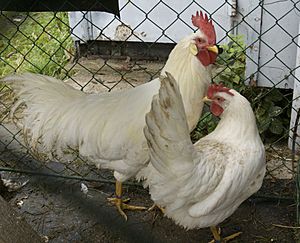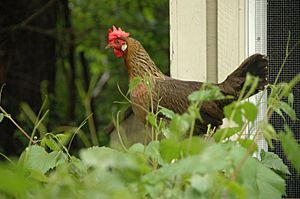Leghorn chicken facts for kids

Cock and hen
|
|
| Conservation status | FAO 2007: not at risk |
|---|---|
| Other names |
|
| Use | eggs |
| Traits | |
| Weight |
|
| Skin colour | yellow |
| Egg colour | white |
| Comb type | single or rose |
| Classification | |
| APA | Mediterranean |
| EE | yes |
| PCGB | soft feather: light |
|
|
The Leghorn (also called Livorno or Livornese in Italy) is a popular type of chicken. This breed first came from Tuscany, a region in central Italy.
These chickens were first sent to North America in 1828. They sailed from the Italian port city of Livorno. At first, people called them "Italians." But by 1865, they became known as "Leghorns." This name is the traditional English way to say "Livorno." The breed then arrived in Britain from the United States in 1870. Today, White Leghorns are very common. Many farms around the world use them to lay eggs. Other types of Leghorns are not as common.
Contents
The History of Leghorn Chickens
The exact beginnings of the Leghorn chicken are not fully clear. It seems they came from lighter chicken breeds found in the countryside of Tuscany. The name "Leghorn" comes from Livorno. This was the port city in Italy where the first chickens were sent to North America.
The first time these chickens were exported is reported differently. Some say it was 1828, others "around 1830," and some even say 1852. They were first known as "Italians." The name "Leghorns" was first used in 1865 in Worcester, Massachusetts.
Leghorns in America
The Leghorn breed was officially added to the American Standard of Perfection in 1874. At that time, three main colors were recognized: black, white, and brown. Later, more varieties were added. In 1883, rose comb light and dark brown Leghorns were included. Rose comb white Leghorns followed in 1886. Single comb buff and silver types were added in 1894. Red, black-tailed red, and Columbian colors joined the list in 1929. Even more colors like rose comb black, buff, silver, and golden duckwing were added in 1981.
Leghorns in Britain
The Leghorn breed first arrived in Britain from the United States in 1870. From Britain, some were even sent back to Italy. White Leghorns that won awards in New York in 1868 were brought to Britain in 1870. Brown Leghorns arrived in Britain starting in 1872.
These early British Leghorns were quite small. They weighed less than 1.6 kg. To make them larger, they were bred with other chicken types. These included Minorca and Malay chickens. New colors also appeared in Britain. Pyle Leghorns were first bred in the 1880s. Gold and silver duckwings came a few years later. These were created by mixing Leghorns with Phoenix or Japanese Yokohama birds. Buff Leghorns were first seen in Denmark in 1885 and in England in 1888.
What Leghorn Chickens Look Like
Leghorn chickens come in many different colors. In Italy, ten color types are officially recognized. There's even a separate Italian standard for a German Leghorn type called the Italiana.
Different countries recognize different varieties. For example, the French poultry federation divides the breed into four main types. They list seventeen color options for full-size birds. They also list fourteen colors for smaller Leghorn bantams. The American Poultry Association recognizes many Leghorn varieties. These include white, red, black-tailed red, light brown, dark brown, black, buff, Columbian, and silver. In Britain, the Leghorn Club recognizes eighteen colors. These include golden duckwing, silver duckwing, partridge, brown, buff, and white.
Most Leghorns have a single, upright comb on their head. A rose comb (a flatter, bumpy comb) is allowed in some countries. However, it is not allowed in Italy. Leghorns have bright yellow legs. Their ear-lobes, which are the fleshy parts below their ears, are white.
Size and Weight
The size of Leghorn chickens can vary slightly by country. In Italy, male Leghorns (cocks) usually weigh between 2.4 and 2.7 kilograms. Female Leghorns (hens) weigh between 2.0 and 2.3 kilograms.
According to the British standard, adult male Leghorns are heavier, at about 3.4 kilograms. Hens weigh around 2.5 kilograms. Younger males (cockerels) weigh 2.7 to 2.95 kilograms. Younger females (pullets) weigh 2 to 2.25 kilograms. For the smaller bantam Leghorns, males weigh up to 1020 grams. Bantam hens weigh up to 910 grams.
How Leghorn Chickens Are Used
Leghorns are known for being excellent layers of white eggs. On average, a Leghorn hen can lay about 280 eggs each year. Some can even lay as many as 300 to 320 eggs per year. Each egg typically weighs at least 55 grams.
White Leghorns are especially important in the egg industry. They have been widely used to create special hybrid chickens. These hybrids are bred to be very productive egg-layers for large commercial farms.


